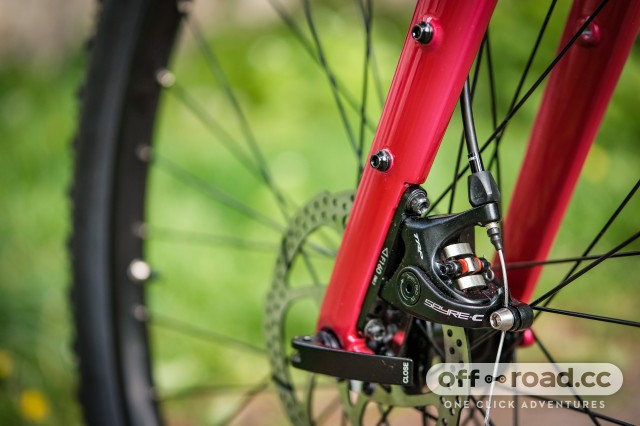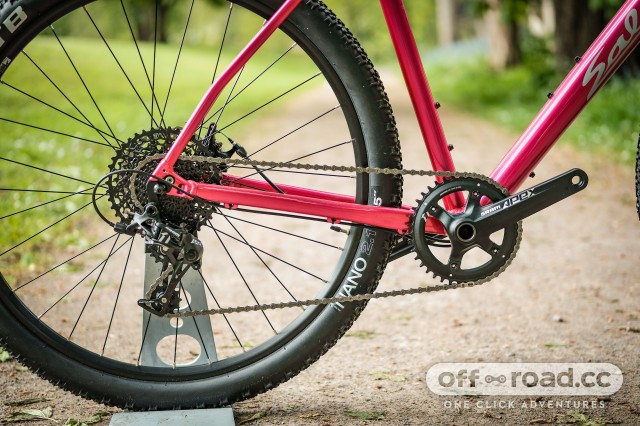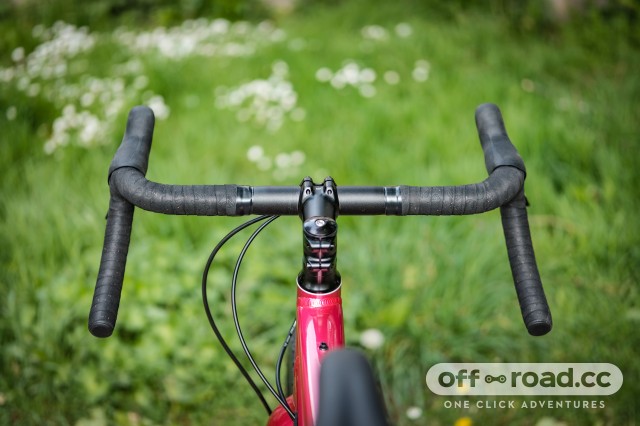Salsa is an iconic bike brand that's been doing off-road capable drop bar bikes longer than most. The Journeyman brings this expertise and experience to a lower price, and there’s a lot to like about this pink beauty. But its beauty is only skin deep. While the ride and handling are very good, and there are some good components, it’s under specced compared to rivals which make it hard to recommend.
- The best gravel and adventure bikes you can buy for under £2,000
- How to go bikepacking: a beginner's guide to getting started
- How to prepare for your first gravel race - kit, bike setup and training
The Journeyman features a smartly designed aluminium frame with internal cable routing, tapered head tube, an external bottle cage and mounts for all sorts of accessories from mudguards to rack and extra bottles. The carbon fork uses Salsa’s Three-Pack mounts for use with the brands' Anything Cages. And it is pink! I think it looks fab, you might not agree, but there are other colours to choose from in the range.
There’s ample tyre clearance. As sold this model comes with 2.1” WTB Nano 650b (or 27.5” in mountain bike parlance) tyres but there are 700c models in the range as well, which this model also accepts. Small fat tyres are all the rage right now, and for good reason; they’re great off-road with bags of comfort and traction.
You could fit a 700c wheel with a narrower gravel tyre, you could even have a second set of wheels for swapsies to suit the terrain and riding style. The Nano tyres are aimed at ensuring the bike is good in the loose, mud and gravel, which it is, but they’re not obscenely slow on harder ground and roads. They’re perhaps not as widely versatile as some 40mm gravel tyres that are faster on harder ground.
It’s disc brakes, naturally, with flat-mount callipers but rather unusually, quick-release axles. There’s nothing wrong with quick-release axles, but most manufacturers have moved to 12mm thru-axles even at this price - Salsa uses them on its more expensive models, so it’s clearly a cost-saving exercise. Many aftermarket wheels use interchangeable end caps so upgrading the wheels or getting spares should be an issue into the future.
Salsa has equipped this model with an SRAM Apex 1 mechanical groupset with TRP Spyre mechanical disc brakes, WTB ST i23 rims with Novatech hubs and WTB Nano tyres. All the finishing kit is Salsa branded stuff, including the slightly flared aluminium drop handlebar. A WTB saddle completes the build, which on our scales comes in at 11.6kg (25.57lb). Yes, that’s a lot of heft, and it does blunt the performance a bit.
Salsa has been doing gravel bikes for yonks, its Warbird one of the first to hit the market many years ago when gravel was just an inkling in the eye of the wider bike industry. So it knows how to do geometry but for the Journeyman, to make it a bit more accessible, the key numbers and angles have been dialled back to make it more suitable for a wider range of cyclists.
So the handling is more laidback than Salsa’s out and out gravel racing bike. The Journeyman is for more relaxed paces, riding through forests like this one, exploring and going the distance in comfort and with all your supplies
The long-wheelbase gives really good stability and in combination with the chunky WTB Nano tyres, this is one rock-solid ride on loose and rocky terrain. The slacker head angle helps to provide calm steering. If you want twitchy this is not the bike for you. I can see this bike being right at home laden with bikepacking paraphernalia and trekking across the plains and mountain ranges.
Embark on a longer rider over challenging and varying terrain, taking in everything from country lanes to gravel byways, and the Journeyman is a competent mile-muncher. The comfort from the bigger tyres is very good, and there’s no sense of excessive stiffness from the aluminium frame when you’re bouncing over roots.
The slightly flared drop handlebar provides a bit more confidence at high speeds and the short stem gives you the ability to tuck and weave around trees on tighter trails.
SRAM’s Apex groupset works well. There’s ample range for dealing with the steeper climbs you always find in the woods compared to on the road, and though the gaps might be bigger than a 2x drivetrain, it’s easy to adapt to, especially when riding off-road trails. The compact hoods are nicely ergonomic compared to the taller hydraulic SRAM hoods more common on gravel bikes we’ve tested here at off.road.cc.
However, the lack of power from the TRP Spyre brakes compared to SRAM’s hydraulic disc brakes is highlighted further by the high weight of the Journeyman. On some steeper descents at higher speed controlling speed is a more challenging task than I was used to with hydraulic disc brakes.
While there’s nothing inherently wrong with the choice of mechanical disc brakes, there are bikes at this price, or cheaper in some cases, that offer hydraulic disc brakes.
Then there is the weight. When you’re faced with a steep climb or you riding very undulating terrain, the high weight takes it toll. And when I say it’s heavy, I’m talking with relation to other bikes at or around this price point that offers a lower weight bike. Add some bags, cages and other assorted accessories, and you could be facing a very heavy bike to lug across the landscape on your micro-adventure.
Rivals
The challenge for the Journeyman is better specced and better value rivals. The Canyon Grail AL 7.0 SL (£1,449) offers a better SRAM Rival 1 groupset with hydraulic disc brakes and DT Swiss C 1850 Spline wheels, and a complete bike weight of 9.3kg that embarrasses the Journeyman.
For a bit more money, there’s the Vitus Substance GRX. It costs £1,799 but you do get a full carbon fibre frame which helps to bring the weight down to just over 9kg. It’s similarly equipped with mounting points and runs 650b tyres. And it’s got a full SRAM Apex 1 groupset with hydraulic disc brakes.
In summary
The Journeyman is a lovely looking bike and it rides very well, with bags of versatility to suit everything from commuting to bikepacking adventures. The chunky tyres and geometry give good capability on mixed terrain, but with these tyres, it’s more at home in the rough. But the weight, the mechanical disc brakes and quick-release axles smack of cost-saving and unfortunately blunt the performance, and make it tricky to recommend when they are better specced and lighter bikes with just as much capability.








